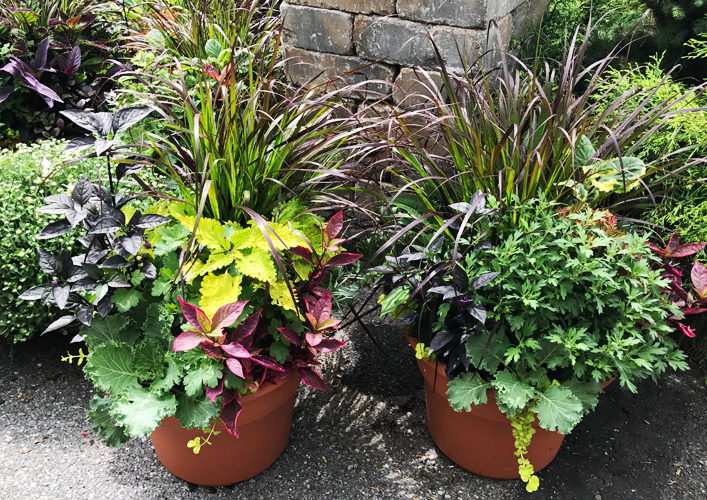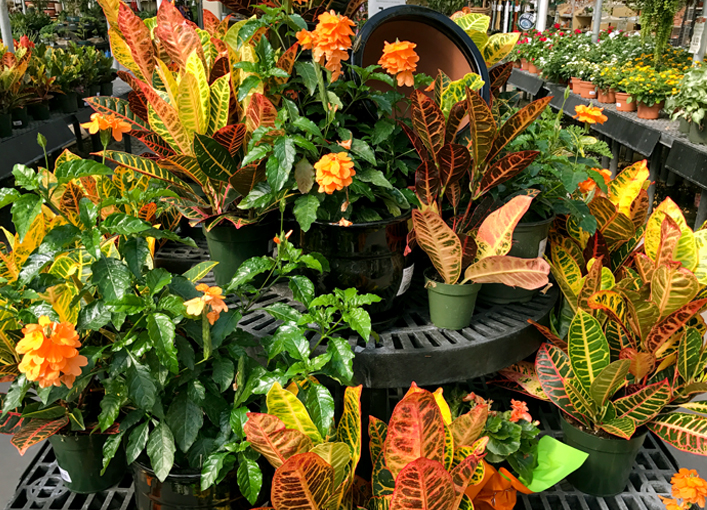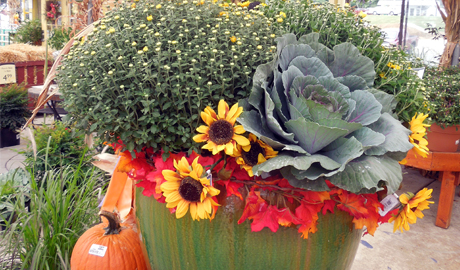How to Create and Care for Fall Containers

As the weather turns crisp, you may notice festive fall decor popping up on front porches around your neighborhood. If your porch is looking bare, you just need a simple way to start. Fall containers can create a beautiful display of fall color that will last throughout the season.
Choosing the Best Containers for Fall Plants
There are plenty of options for pots or containers that you can use to build your fall container garden. Consider the benefits and disadvantages of each option.
Clay / Terracotta
- Allows roots to breathe
- Needs more frequent watering
- Unglazed terracotta dries out quickly and is best for shady spots, glazed terracotta does well in the sun
- May not withstand freezing temperatures
Plastic
- Non-porous, so less watering is needed
- Very lightweight, which has pros and cons — they’re easy to move, but also easy to knock over
- Frost-proof and durable
- Endless options for colors and shapes
Metal
- Conducts heat, which can overheat roots
- Rust can negatively affect soil health
Stone
- Frost-proof material holds up when temps start to drop
- Stone material can last for years
Wood
- Solid wood is great for water retention
- Wooden crates or wooden baskets, however, may need a liner
For unique containers that incorporate more fall decor, consider using a large pumpkin or gourd as your planter. Our advice: if it can hold soil, you can use it as an outdoor planter! No matter what type of container you choose, it needs to include drainage holes to prevent root rot that’s caused by excessive moisture. If your container has a liner, it should also include drainage holes.
If you’re reusing an old container, get it ready for the season by removing any remaining soil or debris and washing it with a solution of three parts water and one part vinegar.

Fall Container Plants That Impress
Now comes the fun part! But with so many colorful options available it can be hard to know where to start. When choosing plants for your fall containers, be sure to include these three elements: thrillers, fillers, spillers.
Thrillers
Thrillers are the centerpiece of your planter. Choose a tall, upright plant with unique qualities such as colorful foliage, intriguing shape, or dramatic flowers. Place your thriller plant in the center of the pot so it can be viewed from all sides. Base the size of your tallest plants on the size of your container. Choose something 1.5 times the height of your container. If your container is lightweight, use stones in the bottom to counterbalance tall plants.
Examples of fall thrillers: fountain grass or butterfly bushes
Fillers
As the name implies, filler plants fill up the pot, adding mass to the composition, as well as texture and color. It’s encouraged that you choose a mixture of filler plants in your container. When planting fillers, surround and weave them through the thrillers in the center.
Examples of fall fillers: pansies, mums, and ornamental cabbage or kale.
Spillers
Spillers sprawl over the side of the container, tumbling to the ground and softening the edges of your planter. When container plants spill over to touch the ground, the creation looks rooted or grounded in its location. Spillers can either complement or contrast other plants in the composition through shape, color or texture.
Examples of fall fillers: coralbells or Lysimachia.
Fall Container Color Combinations
There are theories to follow when choosing a color scheme for your outdoor planters. You can select colors that harmonize or colors that contrast.
Harmonize — Use different shades of a single color or pair colors that sit close to each other on the color wheel (yellow/orange or pink/purple).
Contrast —Use colors that sit opposite each other on the color wheel (purple/yellow or blue/orange).
For fall containers, you can’t go wrong choosing plants in seasonal colors like rich purple, red, bronze, yellow, or orange.
Check out our list of flowers that will add beautiful color and interesting texture to containers all throughout the fall season.
The Best Soil for Fall Outdoor Planters
For healthy outdoor planters, it’s important to start with a good quality potting soil. Typically, the best options include a base of peat moss with other nutrients added in. Garden soil is not an option that we recommend. In addition to being too heavy, it’s not sterile and can house seeds, insects, or fungus which can harm your plants right from the start.
You’ll only need 8 – 10 inches of potting soil to establish roots and your soil should stop 1 – 2.5 inches below the rim of your container. If you’re using a very large pot, this amount of soil may not come close to filling your container. But, don’t waste extra soil just to fill the empty space. Instead, reuse packing peanuts or old soda bottles to fill the empty space in the bottom and “lift” your plants.
Caring for Your Fall Containers
A container bursting with plants means lots of crammed roots down below that require lots of watering and nutrients.
Overwatering is the reason most container plants die, but it’s still a task you’ll need to do often. Check the first inch of soil in your planters. If it’s dry, it’s a sign that it’s time to water. In an Indian summer with unseasonably hot days, you’ll need to water every day. Be sure to empty any plant saucers with each watering.
Unfortunately, a lot of watering can wash away essential nutrients in the soil. In addition to a time-release fertilizer, which you should add upon initial planting, add a liquid fertilizer each week at half strength. Choose a fertilizer that is low in nitrogen and high in phosphorus.
For more advice and a list of supplies for creating a stunning fall container display, talk to the experts at one of our local Home and Garden Centers.

